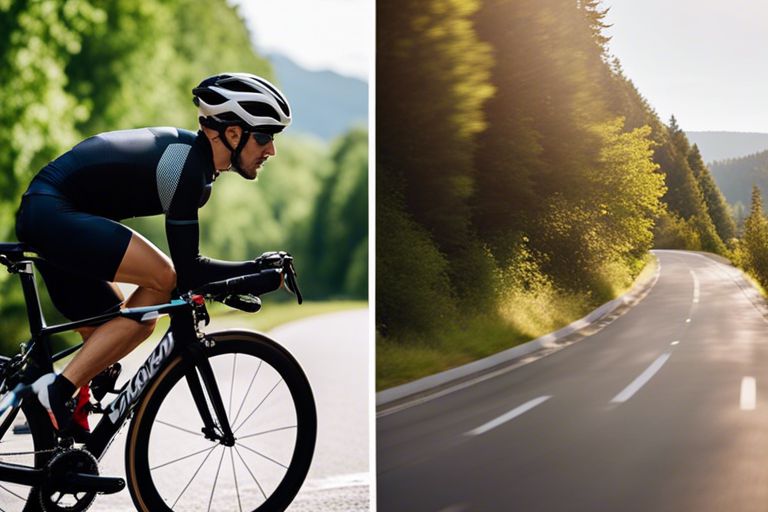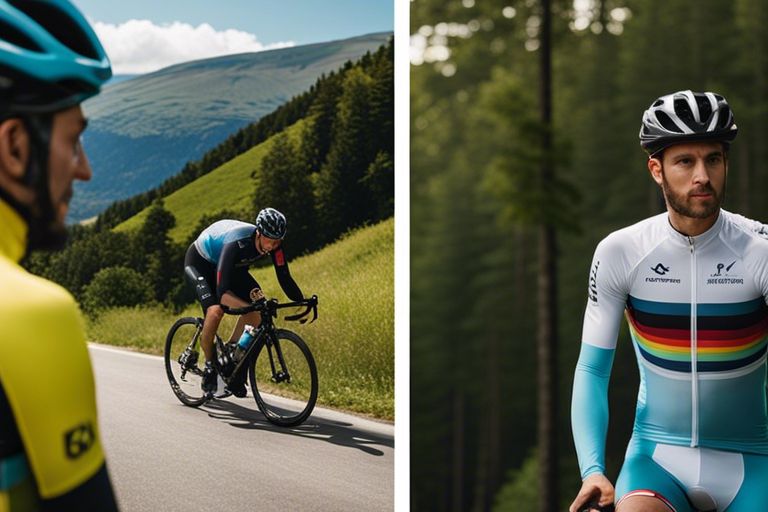You may be faced with the decision of choosing between long-sleeve and short-sleeve cycling jerseys for your next ride, and it’s important to understand the differences to make the right choice. Long-sleeve jerseys offer more coverage and protection from the elements, while short-sleeve jerseys provide better breathability and flexibility. In this guide, we will explore the benefits of each option to help you determine which type of cycling jersey best suits your needs and preferences.

Key Takeaways:
- Long-Sleeve Jerseys: Provide better protection from cold weather and sun exposure, making them ideal for fall or winter cycling.
- Short-Sleeve Jerseys: Offer better breathability and are more suitable for hot weather conditions, keeping the cyclist cool and comfortable during rides.
- Layering: Long-sleeve jerseys can be layered with base layers or arm warmers for versatile temperature control, while short-sleeve jerseys are more limited in this aspect.
- Performance: Short-sleeve jerseys are often preferred for high-intensity rides during warmer months for better moisture-wicking abilities and aerodynamics.
- Personal Preference: The choice between long-sleeve and short-sleeve jerseys ultimately depends on the individual cyclist’s riding habits, climate, and comfort preferences.
Understanding Cycling Jerseys
History and Evolution
To understand the significance of cycling jerseys, it’s crucial to investigate into their history and evolution. Originally, cyclists used simple wool garments for racing. Over time, advancements in fabric technology and aerodynamics have revolutionized the design of cycling jerseys, making them an important element of a cyclist’s gear arsenal.
Materials and Technologies Used
One of the key factors that differentiate cycling jerseys is the materials and technologies used in their construction. Modern cycling jerseys are made from high-performance synthetic materials like polyester and elastane, designed to wick away sweat, enhance breathability, and provide a perfect fit. Advanced technologies such as laser-cut ventilation, seamless construction, and aerodynamic patterning contribute to the overall performance of the jersey.
Understanding the materials and technologies used in cycling jerseys is important for choosing the right option based on your riding style and preferences. Whether you opt for a short-sleeve or long-sleeve jersey, selecting one with the appropriate materials and technologies can significantly impact your comfort and performance on the bike.
Long-Sleeve Cycling Jerseys
Benefits for Different Climates
On cooler days or in colder climates, long-sleeve cycling jerseys provide added warmth and protection from the elements. They are designed to wick away moisture, keeping you dry and comfortable during your ride. Additionally, the long sleeves offer an extra layer of sun protection, which can be beneficial in sunny but cool weather.
Optimal Use Scenarios
Any avid cyclist knows the importance of having a versatile cycling wardrobe. Long-sleeve jerseys are ideal for those transitional seasons like spring and fall when the weather can be unpredictable. They can also be a great layering piece in the winter months, providing extra insulation under a jacket or vest.
For instance, if you are planning a mountain bike ride in the early spring when temperatures are still brisk, a long-sleeve jersey can be the perfect choice to keep you comfortable throughout your adventure. Its moisture-wicking properties will help regulate your body temperature as you tackle challenging terrain.

Short-Sleeve Cycling Jerseys
Advantages for Warmer Weather
For cyclists riding in hot conditions, short-sleeve cycling jerseys offer excellent ventilation to keep the body cool and comfortable. The shorter sleeves allow for better airflow around the arms, preventing overheating during intense rides in the sun.
Combining with Other Cycling Gear
Warmer weather calls for lighter and more breathable cycling gear, and short-sleeve jerseys are the perfect choice for this. These jerseys can be easily combined with arm sleeves or a lightweight vest for added sun protection or to adjust to changing temperatures during the day.
Other accessories like cycling gloves and sunglasses can also be paired with short-sleeve jerseys to enhance comfort and performance on the bike. The versatility of short-sleeve jerseys makes them a staple in every cyclist’s wardrobe, especially during the warmer months.

Factors to Consider When Choosing Between Long-Sleeve and Short-Sleeve
Not all cycling jerseys are created equal. When deciding between a long-sleeve and a short-sleeve option, there are a few factors to take into consideration.
- Material and Fabric Technology
- Personal Comfort and Fit Preferences
- Seasonality and Weather Conditions
- Style and Design Preferences
Perceiving the various aspects of these factors will help you make an informed decision on which type of cycling jersey is best suited to your needs.
Personal Comfort and Fit Preferences
Preferences for personal comfort and fit play a crucial role in choosing between a long-sleeve and short-sleeve cycling jersey. Some cyclists might prefer the snug fit and added warmth of a long-sleeve jersey, while others may opt for the breathability and flexibility of a short-sleeve option. It ultimately comes down to what feels most comfortable and supportive for your riding style.
Seasonality and Weather Conditions
For cyclists, seasonality and weather conditions are key considerations when selecting a cycling jersey. When cycling in colder temperatures or windy conditions, a long-sleeve jersey can provide added insulation and protection. On the other hand, in hot and humid weather, a short-sleeve jersey with moisture-wicking properties can help keep you cool and comfortable during your ride.
When choosing between long-sleeve and short-sleeve jerseys, it’s necessary to consider the weather conditions in which you’ll be cycling most frequently. Having the appropriate attire for different seasons can enhance your overall cycling experience and performance.
Summing up
Upon reflecting on the debate between long-sleeve and short-sleeve cycling jerseys, it is clear that both options have their advantages depending on the conditions and preferences of the rider. Long-sleeve jerseys provide added protection from the elements and sun exposure, making them ideal for cooler weather or long rides. On the other hand, short-sleeve jerseys offer breathability and flexibility, making them a popular choice for warmer days and more intense rides. Ultimately, the decision between long-sleeve and short-sleeve jerseys comes down to personal preference and the specific needs of the cyclist. Both options offer unique benefits and can enhance the overall cycling experience when chosen wisely.
FAQ
Q: What are the benefits of wearing a long-sleeve cycling jersey?
A: Long-sleeve cycling jerseys provide better protection from the sun, wind, and cold temperatures. They are ideal for cooler weather conditions and offer added coverage for your arms during long rides.
Q: When should I opt for a short-sleeve cycling jersey?
A: Short-sleeve cycling jerseys are perfect for hot weather conditions or intense workouts where breathability and moisture-wicking properties are vital. They allow for better ventilation and keep you cool during vigorous rides.
Q: Can I wear a long-sleeve jersey in warm weather?
A: While long-sleeve jerseys are designed for cooler temperatures, there are lightweight options available that offer breathability and UV protection, making them suitable for warm weather cycling. Look for jerseys with mesh panels or moisture-wicking fabrics for optimal comfort.




